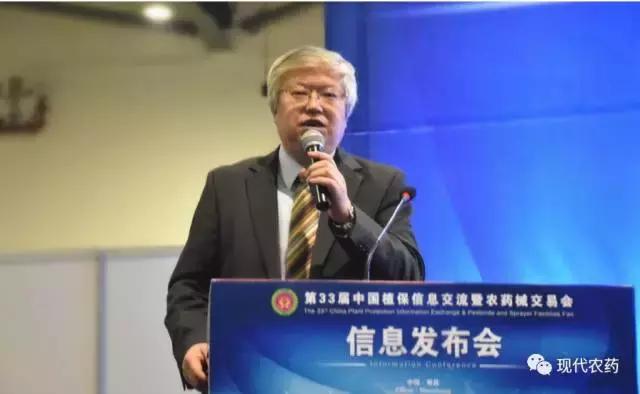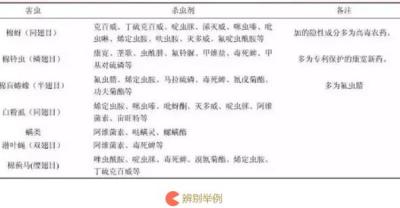Progress in the creation of Green Pesticide and main varieties of Green Pesticide in China
Author: pesticide News Modern Pesticide
The purpose of early pesticide application is to be effective, and the dosage is generally large. With the long-term, excessive and frequent use of pesticides, pesticides have a lot of impact on the ecological environment. Food security, food security and ecological security have become major issues in the world today, and green pesticides have become an urgent need to replace traditional pesticides.
Li Zhong, a professor at East China University of Science and Technology, made a report entitled "Progress in the Development of Green pesticides in China" at the information conference of the 33rd China Plant Protection double Fair. Taking pesticides as an example, he introduced the concept of green pesticides. Pesticides with ultra-high efficiency (dosage per mu less than 5g), low toxicity (LD50 > 2000mg/kg), safety (environmental safety; low toxicity to bees, birds, fish and silkworm; in line with environmental toxicity and other international pesticide production license standards) are called green pesticides.

Li Zhong, Professor of East China University of Science and Technology
As we all know, the creation of pesticides is a very complex, multi-disciplinary integrated system engineering, which costs a lot of money and takes a long time. Over the years, the global pesticide creation is mainly led by the United States, Japan, Germany, Switzerland, the United Kingdom and so on. In 2002, the concept of pesticide creation changed from "environmentally harmonious pesticide" to "green pesticide". China is the earliest proponent of green pesticides. In 2003, the creation of green pesticides was formally listed in the National key basic Research and Development Plan (973 Plan), which marked the recognition of the creation of green pesticides in China. Professor Li Zhong divided the creation of green pesticides in China into three stages: the discovery and research of the leading structure and action targets of green chemical pesticides from 2003 to 2008, the innovative research of green chemical pesticides guided by molecular targets from 2010 to 2014, and from 2017 to 2020, agricultural biomedicine molecular target discovery and green drug molecular design.
In the 973 program, important achievements have been made in the construction of the platform for molecular design of green chemical pesticides and the platform for comparative biochemistry and chemical biology. Professor Yang Guangfu of Central China normal University put forward the study of agricultural properties, the theory of pesticide molecular design based on target conformational flexibility, target-oriented pharmacophore fragment connection molecular design and virtual screening, and the prediction of target resistance about the difference between sensitive targets and resistant targets. Professor Xi Zhen of Nankai University proposed a design method of highly selective PPO inhibitors based on structural differences of target species and a quantitative structure-activity method for selective prediction of target mutagenic resistance pesticides. Professor Yang Xinling of China Agricultural University proposed the design method of insect behavior regulator guided by odor binding protein, and Academician Qian Xuhong of East China University of Technology constructed the information database of pesticide molecular targets. Yang Qing of Dalian University of Technology explored the potential targets based on sequence and structural differences and potential targets based on physiological and functional characteristics, and determined the structure and complex structure of the potential targets.
At the meeting, Professor Li Zhong focused on a number of important green varieties that emerged in the 973 project.
The main results are as follows: (1) Fluorophos, an antiviral immune activator. Fluorophos was created by Guizhou University and then transferred to Guangxi Garden biochemical Co., Ltd for industrial development. Toxic fluorophosphate was obtained by introducing F atom and heterocyclic structural unit using natural aminophosphonic acid and amino acid as template. This variety is the first immune-induced crop virus disease control agent in the world. it is environment-friendly and accords with the idea of green pesticide development.
(2) fungicides PMDD-5Y, PMDD-19. Both were created by China Agricultural University. PMDD-5Y, led by botanical active compounds, can inhibit mycelium growth and spore germination. It has a wide activity spectrum and excellent control effect on rice sheath blight and wheat take-all disease. PMDD-19 is a natural quinoline, which is effective against rice sheath blight, melon and fruit rot, tomato gray mold, rice evil seedling disease, tomato early blight, corn leaf spot, pepper anthracnose and rape sclerotiorum, especially for apple rot.
(3) Green insecticide guadipyr. Amidoprid guanidine, created by China Agricultural University, has an inhibitory effect on nAChR and sodium channels, and has high control effect on piercing mouthparts pests. Its toxicity is very low, and its toxicity to bees, earthworms and other environmental organisms is much lower than that of new nicotine insecticides such as imidacloprid, and it is easy to be metabolized and degraded with little environmental and ecological impact. Imidacloprid guanidine is an ideal substitute for new nicotine insecticides, but it is highly toxic to Trichogramma.
(4) Bactericide pyrimorph. Butylpyrroline, also created by China Agricultural University, has a dual mechanism of affecting the polar distribution of newly synthesized cell wall substances and inhibiting cell energy synthesis (complex Ⅲ). It is environment-friendly, has low toxicity to bees and silkworms, and has low risk of resistance. Pyrrolidine is suitable for controlling downy mildew, blight, blight, black shank, rice blast, rice false smut, anthracnose and so on.
(5) green fungicide benzothiocarbamate. Benzothiamate is a green fungicide with high efficiency, low toxicity and low residue, which is created by Central China normal University. It has been transferred to Jiangsu Qizhou Green Chemical Co., Ltd for industrial development. At the dosage of 1g / mu, it has broad-spectrum bactericidal activity against powdery mildew, downy mildew, brown spot, anthracnose, scab and other major diseases, and its production cost is low.
(6) Green fungicides chlorophenyl ether amide and fluorophenyl ether amide. Both of them were created by Central China normal University and have been transferred to Beijing Yanhua Yongle Biotechnology Co., Ltd for industrial development. Both of them are new succinate dehydrogenase inhibitors, which have internal absorption and conductivity and are resistant to Rain Water shower. At the dosage of 5g / mu, chlorophenyl ether amide had excellent control effect on Botrytis cinerea and rice sheath blight, as well as soybean rust, Sclerotinia sclerotiorum, corn rust and wheat leaf blight. Its control effect and cost against Botrytis cinerea are obviously better than those of acetamiprid. At the dosage of 5g / mu, fluorophenyl ether amide has excellent control effect on rice sheath blight, as well as powdery mildew, soybean rust, corn rust and wheat leaf blight. Its control effect and cost are obviously better than those of similar fungicides thiofuramide.
(7) Super efficient herbicides quinolone and methyl quinolone. Both of them were created by Central China normal University and have been transferred to Shandong Xianda Agrochemical Co., Ltd for industrial development. Both of them are HPPD inhibitors with novel skeleton (quinazolinone), which show high herbicidal activity and good quick effect on many broad-leaved weeds and Gramineae weeds. Quinolone is a selective super-efficient herbicide for sorghum with wide herbicide spectrum and low dosage (5-7.5 g / mu). It has special effect on Setaria viridis and wild millet, and its control effect is significantly better than that of similar herbicide nitrafenone. It is highly safe for sorghum and very safe for corn and wheat. At a very low dosage (1g / mu), methylquinolone showed excellent control effect on Setaria viridis, which was significantly better than that of oxazolidone and nitrazolone. It is safe to corn, but the safety coefficient is not as good as that of Bao Wei.
(8) A new candidate bactericidal compound, azolyl ether sulfonamide. Azolyl ether sulfonamide ester, created by Central China normal University, has a novel action mechanism, which is different from that of existing fungicides. It has a special effect on downy mildew, and its activity is basically the same as that of indazosulfan, which is significantly better than that of cyanofrozole, and it also has a certain control effect on bacterial diseases such as rice bacterial blight.
(9) fungicides coumoxystrobin and pyraoxystrobin. Both of them are methoxyacrylate fungicides created by Shenyang Research Institute of Chemical Industry. Syringomycetin is composed of two natural product fragments, which only contains carbon, hydrogen and oxygen. It has the characteristics of low toxicity, low residue, safety and environmental protection, and has excellent activity for the control of apple rot. Azoxystrobin has broad-spectrum bactericidal activity, and the crops treated by azoxystrobin have good growth, good disease control effect and significant yield increase.
(10) herbicide SYP-3356. SYP-3356 is a uracil herbicide under study, which has a good control effect on broad-leaved weeds and Gramineae weeds, and is effective against resistant weeds such as Euphorbia angustifolia and Euphorbia sibirica.
(11) fungicides SYP-3810, SYP-3773. SYP-3810 and SYP-3773 are pyrimidine amine fungicides under study, both of which have low toxicity and have good control effect on cucumber downy mildew.
(12) a new type of plant-induced disease resistance activator, fluazol activated ester. Fluazol activated ester was created by East China University of Science and Technology and is now transferred to Jiangsu Nantong Taihe Chemical Co., Ltd. for industrial development. Fluazol activated ester is a new mechanism of disease resistance activator designed by synthesis. after simple foliar spray, it can activate plant immune system and resist plant diseases and soil-borne diseases.
(13) piperidine and cypermethrin were created by East China University of Science and Technology, both of which are cis-neo-nicotine insecticides. Piperidine was industrially developed by Jiangsu Kesheng Group Co., Ltd., and is now registered in China. It is a new type of pest agonist, which has internal absorption and conduction activity, is safe to honeybees and lasts for a long time. Epichlorpyridine has a good control effect on Lepidoptera pests and has significant activity against imidacloprid resistant pests. The insecticide Resistance Management Committee (IRAC) listed epirubin as a potential insecticide in the future, which is also the only domestic self-developed insecticide.
- Prev

Which vegetables have high pesticide residues? The ranking of pesticide residues in vegetables is as follows.
Agricultural quality Supervision and Inspection Center of the highest ranking list of Pesticide residues once conducted a study on vegetable agricultural residues and drew such a conclusion: with regard to pesticide residues.
- Next

Is white frost on grape skin a pesticide? Officials avoid rumors: it's not pesticides, it's fruit fans.
Li Yunhui, a reporter from Jiangxi, China, reported that August and September is the season for concentrated listing of grapes. Recently, it has spread in the circle of friends of many citizens.
Related
- Fuxing push coffee new agricultural production and marketing class: lack of small-scale processing plants
- Jujube rice field leisure farm deep ploughing Yilan for five years to create a space for organic food and play
- Nongyu Farm-A trial of organic papaya for brave women with advanced technology
- Four points for attention in the prevention and control of diseases and insect pests of edible fungi
- How to add nutrient solution to Edible Fungi
- Is there any good way to control edible fungus mites?
- Open Inoculation Technology of Edible Fungi
- Is there any clever way to use fertilizer for edible fungus in winter?
- What agents are used to kill the pathogens of edible fungi in the mushroom shed?
- Rapid drying of Edible Fungi

